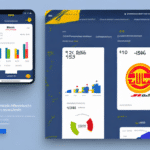Implement a Multi-Carrier Shipping Solution to Save Money on E-commerce Shipping
In the competitive landscape of direct-to-consumer (DTC) e-commerce, managing shipping costs effectively is crucial for maintaining profitability and customer satisfaction. Implementing a multi-carrier shipping solution can significantly reduce shipping expenses by allowing businesses to compare rates from various carriers and select the most cost-effective and reliable options.
Benefits of a Multi-Carrier Shipping Solution
1. Cost Savings Through Competitive Rate Comparison
A multi-carrier shipping solution enables businesses to compare rates from multiple shipping carriers such as UPS, FedEx, DHL, and USPS. By evaluating these rates, e-commerce businesses can choose the most economical option for each shipment, leading to substantial cost savings over time. According to a Statista report, shipping costs account for approximately 10-15% of total e-commerce expenses.
2. Enhanced Shipping Efficiency
Automating the shipping process through a multi-carrier solution reduces manual tasks like label creation and carrier selection. This automation not only saves time but also minimizes the risk of human error. Streamlined operations allow businesses to handle higher order volumes without compromising on delivery speed or accuracy.
3. Improved Customer Experience
Offering multiple shipping options increases customer satisfaction by providing flexibility in delivery times and costs. Customers can choose the shipping method that best fits their needs, whether they prioritize speed or affordability. Enhanced tracking capabilities also keep customers informed about their order status, fostering trust and reliability.
4. Increased Visibility and Real-Time Tracking
A comprehensive shipping solution offers real-time tracking and visibility into each shipment's status. This feature allows businesses to proactively address any delivery issues and provide accurate updates to customers. Enhanced visibility also aids in inventory management and demand forecasting.
5. Improved Carrier Management
Managing multiple carriers from a single platform simplifies the process of monitoring and evaluating carrier performance. Businesses can assess metrics such as delivery times, reliability, and customer feedback to make informed decisions about which carriers to prioritize. This strategic management ensures optimal shipping performance and cost-efficiency.
6. Scalability and Flexibility
A multi-carrier solution offers the flexibility to scale shipping operations as the business grows. Whether expanding into new markets or increasing order volumes, the solution can accommodate varying shipping needs without significant infrastructure changes. This scalability supports long-term business growth and adaptability.
Implementing a Multi-Carrier Shipping Solution
Steps to Integration
- Assess Your Shipping Needs: Analyze your current shipping processes, order volumes, and customer expectations to determine the features required in a multi-carrier solution.
- Select the Right Software: Choose a shipping platform that integrates seamlessly with your e-commerce platform and supports a wide range of carriers.
- Configure Carrier Settings: Set up carrier accounts, shipping rules, and preferences within the software to optimize rate selection and delivery options.
- Train Your Team: Ensure that your staff is well-versed in using the new shipping solution to maximize its benefits.
- Monitor and Optimize: Continuously track shipping performance and make adjustments as needed to improve efficiency and cost savings.
Choosing the Right Multi-Carrier Solution
When selecting a multi-carrier shipping solution, consider factors such as ease of integration, user interface, customer support, and the range of supported carriers. Look for platforms that offer robust analytics and reporting tools to help you make data-driven shipping decisions. Reviews and case studies from reputable sources can provide insights into the effectiveness of different solutions.
Case Studies: Success Stories with Multi-Carrier Shipping Solutions
Example 1: Boosting Efficiency for an Online Retailer
An online apparel retailer implemented a multi-carrier shipping solution and saw a 20% reduction in shipping costs within the first six months. By automating carrier selection and leveraging discounted rates, the retailer was able to offer more competitive shipping options to customers while maintaining profit margins.
Example 2: Enhancing Customer Satisfaction for a Tech Gadget Store
A technology-focused e-commerce store integrated a multi-carrier solution to provide faster delivery times and real-time tracking. Customer satisfaction scores increased by 15%, and repeat purchase rates improved as a result of the enhanced shipping experience.
Industry Insights and Trends
Growing Importance of Shipping Optimization
With e-commerce sales projected to reach $6.54 trillion globally by 2023, optimizing shipping processes is more important than ever. Businesses that invest in sophisticated shipping solutions are better positioned to meet customer expectations and stay ahead of the competition.
Integration with Emerging Technologies
Modern multi-carrier shipping solutions are increasingly integrating with technologies like artificial intelligence and machine learning to provide predictive analytics and automated decision-making. These advancements help businesses anticipate shipping trends and optimize their logistics strategies accordingly.
Conclusion
Implementing a multi-carrier shipping solution is a strategic move for direct-to-consumer e-commerce businesses aiming to reduce shipping costs, enhance efficiency, and improve customer satisfaction. By leveraging the benefits of competitive rate comparison, automation, and real-time tracking, businesses can optimize their shipping operations and maintain a competitive edge in the rapidly evolving e-commerce market. Investing in the right shipping technology not only boosts profitability but also fosters long-term customer loyalty.






















